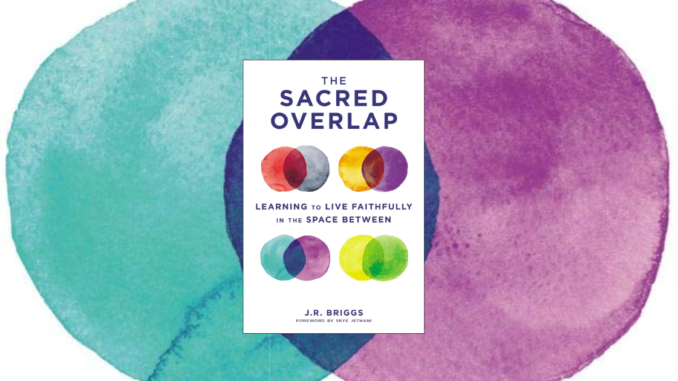
Published by Zondervan on September 8, 2020
Genres: Non-Fiction, Christian Life, Theology
Buy on Amazon
Goodreads

The widening of political, racial, generational, and religious differences often leads to an "us vs. them" mentality all too common today. In The Sacred Overlap, author J.R. Briggs communicates a refreshing vision that embraces tension and calls us to live in radical love and faithfulness between the extremes that isolate and divide people.
Read the gospels and you'll see how Jesus was committed to crossing cultural, social, political and religious either/or waters, engaging in many and/also activities. He comforted the disturbed and also disturbed the comfortable. He was too religious for the pagans and also too pagan for the religious elites. He hung out with filthy lepers and also dined with the filthy rich. He was alarming and disarming at the same time.
This is not a spineless embrace of religious syncretism where we take bits from world religions, personal preferences, and ideologies and throw them into a cosmic blender for a tasty theological smoothie. Instead, Briggs offers a fresh understanding of evangelism and discipleship, showing how we need to be engaged in both of these at the same time. He shares creative ways to engage with God's mission with those who are intrigued about Jesus, but turned off by church. He explores what it means to be joyful in the midst of heart wrenching pain and suffering in the world. And he models what it means to maintain a posture of convicted civility which emphasizes equally both grace and truth.
The Sacred Overlap helps readers see that Christians are called to live with their feet firmly planted in two different worlds--in both heaven and earth--living naturally with grace and truth. Only then can a Christian be a faithful witness in the way of Jesus.
The Sacred Overlap challenges the tribal mindsets in our culture, helping Christians see the importance of being a “both/and” people, instead of grabbing hold of one particular idea and making it mutually exclusive. J.R. Briggs does not encourage a “mushy middle” where people refuse to take moral stands or pretend that wildly divergent views are equally correct, but he helps Christians recognize the ways that different church denominations and individuals tend to overemphasize one truth while dismissing truths that they ought to hold in tension with whatever they emphasize. Briggs shares personal examples from his own life and ministry and also writes a lot about Jesus, showing how Jesus held truths in tension and infuriated his contemporaries by holding to nuance and refusing to oversimplify issues according to tribal instincts.
In my opinion, Briggs’s treatment of the gospel narratives was the best part of this book. People often co-opt Jesus to make their particular religious or social points, but Briggs clearly represents who Jesus was as a historical person, and does justice to the complexity of what Jesus taught, instead of cherry-picking the sayings that support a worldview or social agenda. I found this very refreshing, and think that this book would be a great choice for people who have a hard time finding the real Jesus in the midst of tribal teachings that ignore the overlap he taught between truths in tension.
A Mixed Bag
However, I wish that Briggs had written more about the intellectual and social challenges that come with thinking through every issue carefully instead of holding to a party line. He makes a convincing case for why this is so important, and he acknowledges that it is difficult at times, but he does not provide much practical advice for how to navigate relationship frustrations within a tribal, polarized world. I went into this book hoping that it would help me deal with the strain of trying to think deeply while others promote their specific ideological camps, but Briggs mainly just writes about all the different ways we can live a both/and life, without focusing on these practical, relational challenges.
The book is also longer than necessary and doesn’t stay focused. Every chapter ties back to the concept of living a nuanced life, but because the author did not narrow his focus to a core thesis and specific applications, the book covers so many different topics and involves so many different illustrations that it seems like multiple books pressed into one. Briggs addresses lots of different issues from society and Christian culture, but his focus is so broad that he can only go deeply into some of the subjects, and even though I know that different readers will connect with different parts of the book, it is somewhat of a mixed bag because of this.
Conclusion
The Sacred Overlap: Learning to Live Faithfully in the Space Between is a great book for someone who is wrestling with their tribal identity and wants a new approach to faith-related and cultural issues. This book provides a vivid picture of Jesus from the gospels, showing how he held truths in tension, lived out the overlap between them, and serves as the perfect example for how we should approach life. However, people who are already living nuanced lives and want advice about how to deal with others’ tribalism will not get the help that they need here, and those who are looking for a deep dive may be turned off by the dizzying array of different topics and issues covered in this book. Still, people who want a general introduction into nuanced Christianity should find this helpful, and can focus on the parts that speak the most to them.
